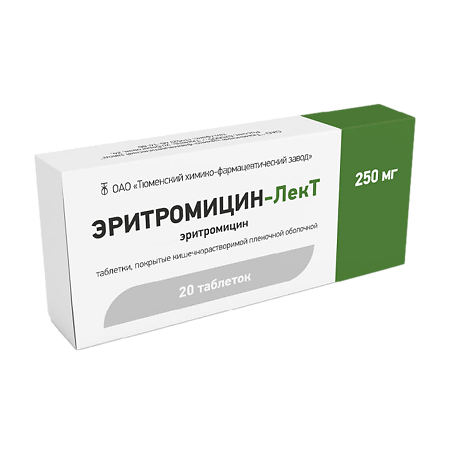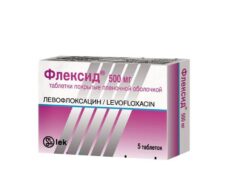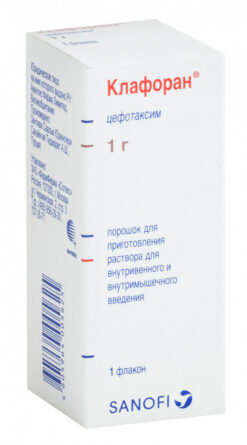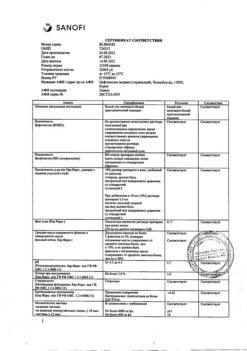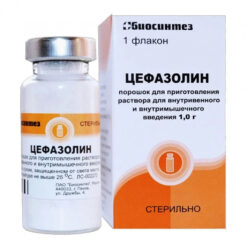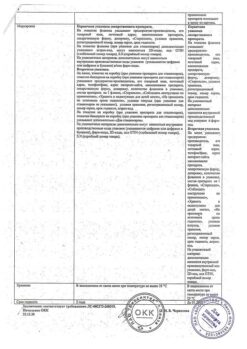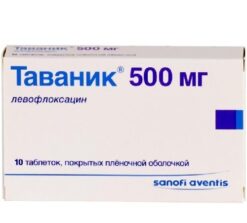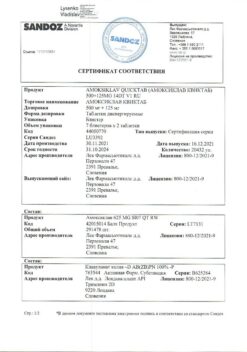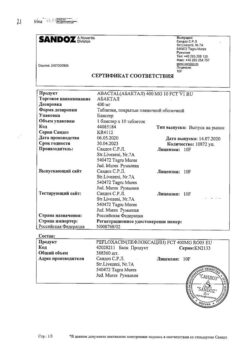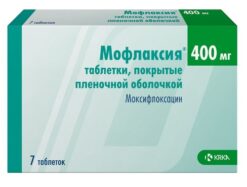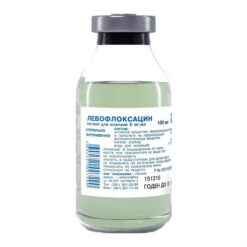No products in the cart.
Erythromycin-LekT, 250 mg 20 pcs
€5.63 €5.00
Description
Bacteriostatic antibiotic of macrolide group. It binds irreversibly to 50S-subunit of ribosomes, which disrupts formation of peptide bonds between amino acid molecules and blocks protein synthesis in microorganisms (does not affect nucleic acid synthesis). When used in high doses depending on the type of pathogen it may show bactericidal effect.
Sensitive microorganisms are those the growth of which is inhibited when the antibiotic concentration is less than 0.5 mg/l, moderately sensitive – 1-6 mg/l, resistant – more than 6 mg/l.
The broad spectrum of antimicrobial activity of erythromycin includes:
Gram-positive microorganisms: Staphylococcus spp, producing and non-producing penicillinase, including Staphylococcus aureus (except strains resistant to methicillin MRSA); Streptococcus spp. (including Streptococcus pneumoniae, Streptococcus pyogenes, Streptococcus spp. viridans group): Bacillus anthracis, Corynebacterium diphtheriae, Corynebacterium minutissimum, Listeria monocytogenes;
Literate microorganisms: Bordetella pertussis, Campylobacter jejuni, Legionella spp.(including Legionella pneumophila), Moraxella (Branhamella) catarrhalis; and other microorganisms: Mycoplasma spp. Neisseria gonorrhoeae, Haemophilus influenzae (some strains may be resistant to erythromycin but sensitive to other macrolide antibiotics);
other microorganisms: Chlamydia spp. (including Chlamydia trachomatis), Mycoplasma spp. (including Mycoplasma pneumoniae), Ureaplasma urealyticum, Treponema spp, Propionibacterium acnes, Entamoeba histolytica.
Eritromycin-resistant Gram-negative bacilli: Escherichia coli and other members of the family Enterobacteriaceae (Klebsiella spp., Proteus spp., Shigella spp., Salmonella spp. and others); Pseudomonas aeruginosa; Acinetobacter spp. And other non-fermenting bacteria, as well as anaerobic bacteria (Bacteroides spp., including Bacteroides Iragilis), methicillin-resistant strains of Staphylococcus aureus (MRSA) and Enterococcus spp. enterococcus microbacteria.
It is a motilin receptor agonist. It accelerates the evacuation of gastric contents by increasing the amplitude of contraction of the pylorus and improving the antral-duodenal coordination; it has prokinetic properties.
Indications
Indications
Infectious and inflammatory diseases caused by microorganisms sensitive to erythromycin: diphtheria (including bacterial carriage), trachoma, brucellosis, legionellosis (Legionnaires’ disease), erythrasma, listeriosis, scarlet fever, amoebic dysentery, gonorrhea; infections of the ENT organs (tonsillitis, otitis media, sinusitis); biliary tract infections (cholecystitis); whooping cough (including prevention); infections of the upper and lower respiratory tract (tracheitis, bronchitis, pneumonia); infections of the skin and soft tissues (pustular skin diseases, including juvenile acne, infected wounds, bedsores, II-III degree burns, trophic ulcers), infections of the mucous membrane of the eyes.
Prevention of infectious complications during medical and diagnostic procedures (including preoperative bowel preparation, dental interventions, endoscopy, in patients with heart defects).
Prevention of exacerbations of streptococcal infections (tonsillitis, pharyngitis) in patients with rheumatism.
Urogenital infections in pregnant women caused by Chlamydia trachomatis; uncomplicated chlamydia in adults (with localization in the lower genitourinary tract and rectum) with intolerance or ineffectiveness of tetracyclines, etc.
Pharmacological effect
Pharmacological effect
Bacteriostatic antibiotic from the macrolide group. Reversibly binds to the 50S subunit of ribosomes, which disrupts the formation of peptide bonds between amino acid molecules and blocks the synthesis of microbial proteins (does not affect the synthesis of nucleic acids). When used in high doses, depending on the type of pathogen, it can exhibit a bactericidal effect.
Microorganisms whose growth is delayed at an antibiotic concentration of less than 0.5 mg/l are classified as sensitive, 1-6 mg/l as moderately sensitive, and more than 6 mg/l as resistant.
The wide spectrum of antimicrobial action of erythromycin includes:
gram-positive microorganisms: Staphylococcus spp., producing and non-producing penicillinase, incl. Staphylococcus aureus (except methicillin-resistant MRSA strains); Streptococcus spp. (including Streptococcus pneumoniae, Streptococcus pyogenes, Streptococcus spp. viridans group): Bacillus anthracis, Corynebacterium diphtheriae, Corynebacterium minutissimum, Listeria monocytogenes;
gram-negative microorganisms: Bordetella pertussis, Campylobacter jejuni, Legionella spp (including Legionella pneumophila), Moraxella (Branhamella) catarrhalis; and other microorganisms: Mycoplasma spp. (including Neisseria gonorrhoeae, Haemophilus influenzae (some strains may be resistant to erythromycin, but sensitive to other macrolide antibiotics);
other microorganisms: Chlamydia spp. (including Chlamydia trachomatis), Mycoplasma spp. (including Mycoplasma pneumoniae), Ureaplasma urealyticum, Treponema spp., Propionibacterium acnes, Entamoeba histolytica.
Gram-negative bacilli resistant to erythromycin: Escherichia coli and other representatives of the Enterobacteriaceae family (Klebsiella spp., Proteus spp., Shigella spp., Salmonella spp. and others); Pseudomonas aeruginosa; Acinetobacter spp. And other non-fermenting bacteria, as well as anaerobic bacteria (Bacteroides spp., including Bacteroides Iragilis), methicillin-resistant strains of Staphylococcus aureus (MRSA) and Enterococcus spp., microbacteria.
It is a motilin receptor agonist. Accelerates the evacuation of gastric contents by increasing the amplitude of pyloric contraction and improving antral-duodenal coordination, and has prokinetic properties.
Special instructions
Special instructions
During long-term therapy, it is necessary to monitor laboratory parameters of liver function.
Symptoms of cholestatic jaundice may develop several days after the start of therapy, but the risk of development increases after 7-14 days of continuous therapy. The likelihood of developing an ototoxic effect is higher in patients with renal and/or liver failure, as well as in elderly patients. Some resistant strains of Haemophilus influenzae are sensitive to simultaneous administration of erythromycin and sulfonamides.
May interfere with the determination of catecholamines in urine and the activity of “liver” transaminases in the blood (colorimetric determination using definylhydrazine).
Do not drink milk or dairy products.
Numerous clinical studies have proven the antral and duodenal prokinetic effect of erythromycin.
Impact on the ability to drive vehicles. Wed and fur.:
Data on negative effects on the ability to drive vehicles and machinery have not been identified, but patients driving vehicles are advised to use the drug with extreme caution.
Active ingredient
Active ingredient
Erythromycin
Composition
Composition
1 tablet contains:
active substance:
erythromycin 292.4 mg, based on the active substance 250 mg.
kernel excipients:
potato starch 132.9 mg,
povidone 11.2 mg,
polysorbate-80 9.0 mg,
calcium stearate 4.5 mg.
Shell excipients:
acetylphthalyl cellulose 13.5 mg,
macrogol-6000 1.0 mg,
titanium dioxide 4.0 mg,
castor bean seed oil 4.0 mg.
Pregnancy
Pregnancy
The use of Erythromycin during pregnancy is possible only when the expected benefit to the mother outweighs the potential risk to the fetus.
During lactation, due to the possibility of penetration into breast milk, you should refrain from breastfeeding when using Erythromycin.
Contraindications
Contraindications
Hypersensitivity to erythromycin and other macrolides; significant hearing loss; simultaneous use of terfenadine, astemizole, pimozide, cisapride, lactation period, children under 14 years of age (for this dosage form).
With caution:
Arrhythmias (history), increased duration of the ventricular complex on the electrocardiogram (prolongation of the QT interval), jaundice (history), liver and/or renal failure, use during pregnancy.
Side Effects
Side Effects
Allergic reactions: urticaria, other forms of skin rash, eosinophilia, anaphylactic shock.
From the digestive system: nausea, vomiting, gastralgia, abdominal pain, tenesmus, diarrhea, dysbacteriosis, oral candidiasis, pseudomembranous colitis (both during and after treatment), impaired liver function, cholestatic jaundice, increased activity of “liver” transaminases, pancreatitis.
On the part of the hearing organ: hearing loss and/or tinnitus (when used in high doses – more than 4 g/day, usually reversible).
From the cardiovascular system: tachycardia, prolongation of the Q-T interval on the electrocardiogram, atrial fibrillation and/or flutter (in patients with a prolonged Q-T interval on the electrocardiogram).
Interaction
Interaction
Reduces the bactericidal effect of beta-lactam antibiotics (penicillins, cephalosporins, carbopenems).
Incompatible with lincomycin, clindamycin and chloramphenicol (antagonism).
Increases the concentration of theophylline.
Increases the nephrotoxicity of cyclosporine (especially in patients with concomitant renal failure).
Reduces the clearance of triazolam and midazolam, and therefore may enhance the pharmacological effects of benzodiazepines.
Slows down the elimination (increases the effect) of methylprednisolone, felodipine and coumarin anticoagulants.
When used together with lovastatin, simvastatin and other statins, the risk of developing rhabdomyolysis increases.
Increases the bioavailability of digoxin.
Reduces the effectiveness of hormonal contraception.
Drugs that block tubular secretion prolong T1/2 of Erythromycin.
When used together with drugs that are metabolized in the liver by the cytochrome P450 system (carbamazepine, valproic acid, hexobarbital, phenytoin, alfentanil, disopyramide, lovastatin, bromocriptine), the concentration of these drugs in plasma may increase (since erythromycin is an inhibitor of microsomal liver enzymes).
When used together with terfenadine or astemizole, arrhythmia may develop (ventricular fibrillation and flutter, ventricular tachycardia, even death), with dihydroergotamine or non-hydrogenated ergot alkaloids – vasoconstriction to complete spasm, dysesthesia.
If you are taking other medications, you should consult your doctor.
Overdose
Overdose
Symptoms: impaired liver function, up to acute liver failure, hearing loss.
Treatment: activated carbon, careful monitoring of the state of the respiratory system (if necessary, artificial ventilation), acid-base status and electrolyte metabolism, electrocardiogram.
Gastric lavage is effective when taking a dose five times higher than the average therapeutic dose.
Hemodialysis, peritoneal dialysis, and forced diuresis are ineffective.
Recommendations for use
Recommendations for use
Inside (the regimen for taking the drug and eating is determined by the dosage form and its resistance to the effects of gastric juice). Take the tablet 1-2 hours before meals or 2-3 hours after meals. The tablet must not be split or chewed. A single dose for adults is 250-500 mg. The average daily dose for adults is 1-2 g in 2-4 doses, the maximum daily dose is 4 g.
Children over 14 years old, depending on age, body weight and severity of infection – 30-50 mg/kg/day in 2-4 doses. In case of severe infections, the dose may be doubled. For the treatment of diphtheria carriage – 0.25 g 2 times a day.
The course dose for the treatment of primary syphilis is 30-40 g, the duration of treatment is 10-15 days.
For amoebic dysentery in adults – 0.25 g 4 times a day, course duration – 10-14 days.
For legionellosis – 0.5-1 g 4 times a day for 14 days.
For gonorrhea – 0.5 g every 6 hours for 3 days, then 0.25 g every 6 hours for 7 days.
For gastroparesis – orally (for the treatment of gastroparesis, erythromycin for intravenous use is more preferable) 0.15-0.25 g 30 minutes before meals 3 times a day.
For scarlet fever – in usual doses, the course of treatment is at least 10 days.
For listeriosis – 250-500 mg 4 times a day for at least 7 days, etiotropic therapy is carried out until the 6-7th day of normal temperature, and for severe forms – until the 14-21st day.
For erythrasma – 250 mg 4 times a day for 5-7 days simultaneously with external agents.
For preoperative bowel preparation to prevent infectious complications – orally, 1 g 19 hours, 18 hours and 9 hours before surgery (3 g in total).
For the prevention of streptococcal infections (for tonsillitis, pharyngitis) adults – 20-50 mg/kg/day, children over 14 years old – 20-30 mg/kg/day, course duration – at least 10 days.
For the prevention of septic endocarditis in patients with heart defects – 1 g for adults and 20 mg/kg for children over 14 years old, 1 hour before a treatment or diagnostic procedure, then 0.5 g for adults and 10 mg/kg for children, again after 6 hours.
For whooping cough – 40-50 mg/kg/day for 5-14 days.
For genitourinary infections during pregnancy – 0.5 g 4 times a day for at least 7 days or (if this dose is poorly tolerated) 0.25 g 4 times a day for at least 14 days.
In adults, with uncomplicated chlamydia and intolerance to tetracyclines – 0.5 g 4 times a day for at least 7 days.
Storage conditions
Storage conditions
Store in a place protected from light, at a temperature not exceeding 25 °C.
Keep out of the reach of children.
Shelf life
Shelf life
2 years.
Do not use after expiration date.
Manufacturer
Manufacturer
Tyumen Chemical Plant, Russia
Additional information
| Shelf life | 2 years. Do not use after the expiration date. |
|---|---|
| Conditions of storage | Store in the dark place at a temperature not exceeding 25 °С. Store out of the reach of children. |
| Manufacturer | Tyumen Chemical Plant, Russia |
| Medication form | enteric-soluble film-coated tablets |
| Brand | Tyumen Chemical Plant |
Related products
Buy Erythromycin-LekT, 250 mg 20 pcs with delivery to USA, UK, Europe and over 120 other countries.

